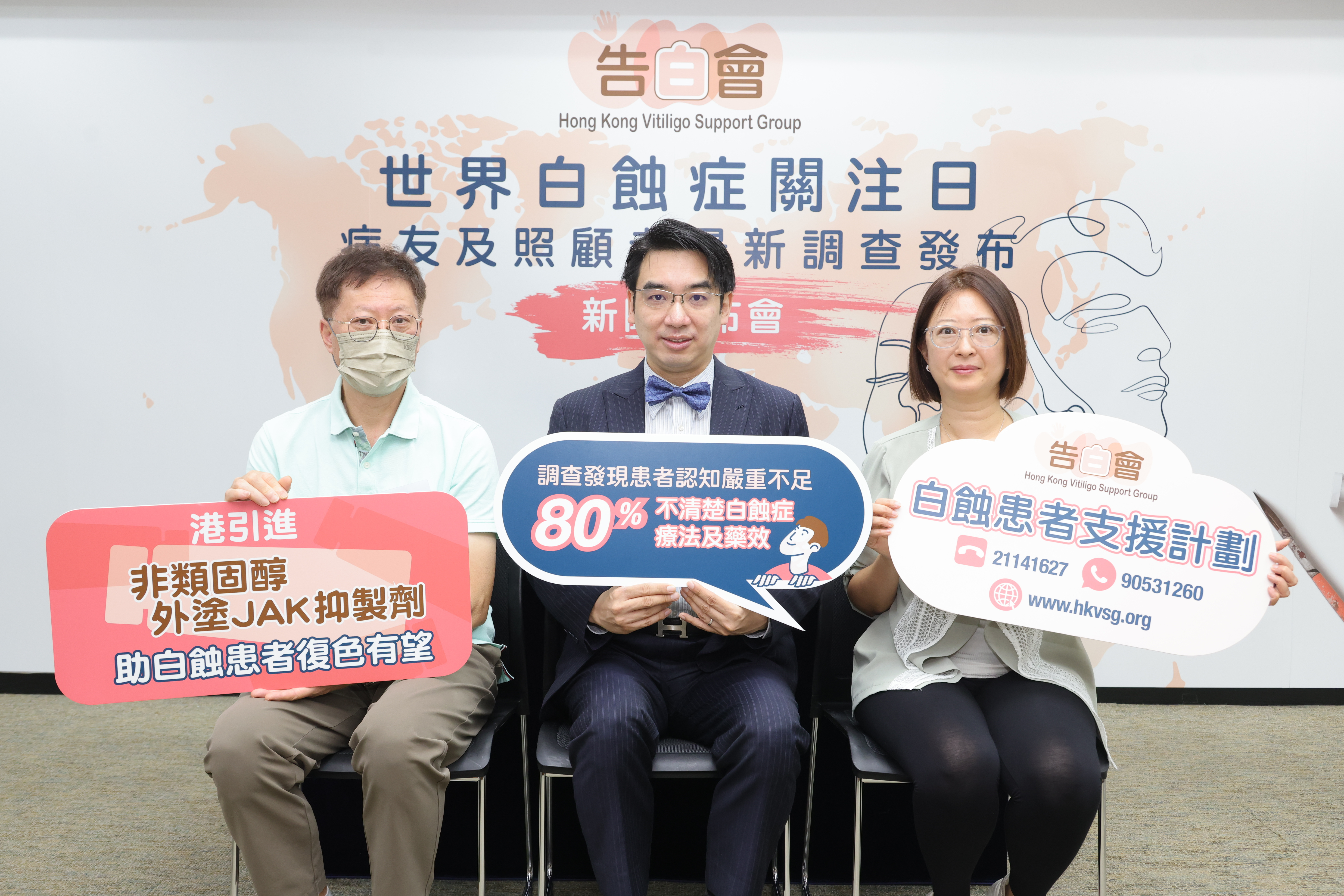Key Findings from the "Hong Kong Vitiligo Patients and Caregivers Survey" Released for "World Vitiligo Day"
Over 70% of Vitiligo Patients Desire Skin Repigmentation; New Topical Therapy Introduced in Hong Kong Shows Encouraging Results
HONG KONG SAR - Media OutReach Newswire - 22 June 2025 - In observance of World Vitiligo Day (June 25), Hong Kong Vitiligo Support Group has released findings from its latest "Hong Kong Vitiligo Patients and Caregivers Survey.
" The study reveals critical gaps in treatment knowledge, with over 80% of respondents demonstrating limited understanding of available therapies and their efficacy. More than 70% of patients hoped therapy could partially or fully restore their original skin pigmentation, yet many reported disappointing outcomes with existing treatments, leading to loss of confidence and treatment discontinuation.

Dr. Chan Yung, a specialist in dermatology, noted that with advancing insights into vitiligo pathogenesis, novel therapy has recently been introduced in Hong Kong. Clinical studies confirm its repigmentation potential, encouraging patients to consult specialists for personalized treatment plans.
In Hong Kong, vitiligo affects approximately 1% of the population, with an estimated 70,000 individuals living with the condition. In May 2025, Hong Kong Vitiligo Support Group successfully surveyed 61 patients or their primary caregivers to identify key challenges in disease management. Key findings as follows:
1. Critical Knowledge Deficits in Treatment Understanding
- 80% lack understanding of treatment options
- 78% unfamiliar with medication efficacy
- 84% uncertain about which specialist to consult
- 74% of respondents expressed a desire for full or partial skin repigmentation, yet among the 48 treated patients, none achieved complete repigmentation, and only 8% reported partial improvement
- 67% perceived treatments as completely ineffective
- 43% are not receiving any active treatment at present
- Barriers included: high private healthcare costs and long public-sector wait times (95%), and perceived futility of therapy (75%)
- Corticosteroids: Risk of skin atrophy, telangiectasia; unsuitable for long-term use
- Phototherapy: Requires 3–6 months (or longer) of 2–3 weekly sessions, with potential sunburn and skin cancer risks
- Non-steroidal topicals: Often only slow progression rather than induce repigmentation
Over 70% of Vitiligo Patients Seek Skin Repigmentation - New Topical Treatment Introduced in Hong Kong Offers Hope
Dr. Chan Yung stated that targeted therapies like topical JAK inhibitors represent a breakthrough in vitiligo treatment. "Topical JAK inhibitors are non-steroidal medications with demonstrated efficacy and safety profiles, making them a viable long-term treatment option for patients," he explained.
While the exact etiology of vitiligo remains unclear, current evidence suggests autoimmune-mediated attack on melanocytes plays a key pathogenic role, resulting in depigmented lesions. Non-steroidal Topical JAK inhibitors work by modulating the aberrant immune signaling responsible for melanocyte attack, enabling gradual repigmentation of affected areas.
Ruxolitinib cream, the first FDA-approved non-steroidal topical JAK inhibitor for localized treatment of non-segmental vitiligo in patients aged 12 years and above, has recently become available in Hong Kong. Clinical trials show:
- Approximately 30% of patients achieved ≥75% improvement in Facial Vitiligo Area Scoring Index (F-VASI) after 24 weeks of treatment;
- 50% of patients showed ≥50% improvement;
- Extension to 52 weeks of treatment resulted in >50% of patients attaining ≥75% improvement7
Ms. Amy Wong, a Registered Social Worker at Hong Kong Vitiligo Support Group noted that many vitiligo patients and caregivers seeking assistance express confusion about treatment options and medication efficacy. "Many patients spend over a year just obtaining a definitive diagnosis," she explained. "In their search for solutions, patients often invest substantial resources in various cosmetic packages and alternative therapies, only to experience significant discrepancies between desired and actual outcomes. This frequently leads to disillusionment, loss of hope for effective treatment, and even emotional distress."
"However," Ms. Wong emphasized, "with medical advancements, vitiligo is no longer considered untreatable. Repigmentation is now achievable, and we strongly encourage patients to seek professional medical consultation at the earliest opportunity."
Conclusion and Recommendations
The survey reveals significant gaps in patients' understanding of vitiligo treatments and their mechanisms, leaving many uncertain about where to begin treatment. Over 80% of respondents expressed desire for patient support in medication access and resource referrals. Accordingly, Dr. Chan Yung and Ms. Amy Wong, propose the following recommendations:
1. Public Education Seminars
Conduct lectures and workshops to help patients and caregivers understand that vitiligo requires long-term management, with visible results often taking extended periods to manifest. These initiatives should also educate participants about various treatment modalities, particularly newly available options like non-steroidal topical JAK inhibitors, enabling informed discussions with healthcare providers about appropriate treatment plans.
2. Medication Support and Resource Referral Services
Given that vitiligo necessitates prolonged treatment, and considering that many patients find private care cost-prohibitive while public service wait times are excessively long, we recommend establishing medication support and resource referral services to facilitate timely access to proper treatment. Hong Kong Vitiligo Support Group is currently implementing a "Vitiligo Patient Support Program," offering free psychological counseling, medication assistance, and resource referral services. Interested individuals may contact Hong Kong Vitiligo Support Group for details.
Case Study
Mr. Chan (pseudonym), 58, first developed symptoms thirty years ago with a small depigmented spot on his neck that subsequently spread to his neck, waist, wrists, and thighs. At diagnosis, his physician prescribed topical corticosteroids but stated vitiligo was essentially "incurable." Mr. Chan subsequently pursued numerous alternative treatments including UV light therapy, traditional Chinese medicine, electroacupuncture, topical shampoo applications, and cosmetic packages - exhausting savings and liquidating his stocks - all without achieving satisfactory repigmentation.
After years of unsuccessful treatment attempts, he discontinued treatment until being referred to the Hong Kong Vitiligo Support Group. Through their seminars and "Vitiligo Patient Support Program", he learned about modern treatment advances and, with medication assistance, has begun new therapy with renewed hope for repigmentation.
"My greatest wish is to wear crew-neck shirts again," Mr. Chan shared. "Since developing vitiligo, I've only worn high-collared shirts to conceal neck patches and haven't gone swimming in thirty years." He looks forward to regaining sartorial freedom following successful repigmentation.
Hashtag: #Vitiligo #WorldVitiligoDay #TopicalJAKinhibitors #Non-steroidalTopicalJAKinhibitors #Ruxolitinibcream #SkinRepigmentation #Dr.ChanYung #Dermatology #Skincare#HongKongVitiligoSupportGroup
https://hkvsg.org/
The issuer is solely responsible for the content of this announcement.
About Hong Kong Vitiligo Support Group
Initiated by social enterprise Hong Kong Health Care Alliance, Hong Kong Vitiligo Support Group is a non-profit patient organization dedicated to individuals affected by vitiligo and their caregivers. Our mission is to enhance societal understanding of vitiligo through comprehensive disease education and support services, empowering patients to better understand and confront their condition while fostering public awareness. We strive to ensure no patient faces this journey alone.

















